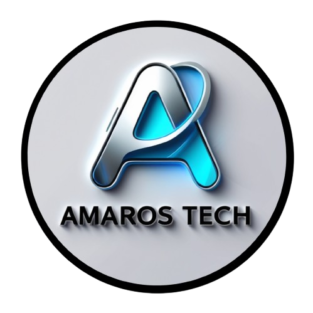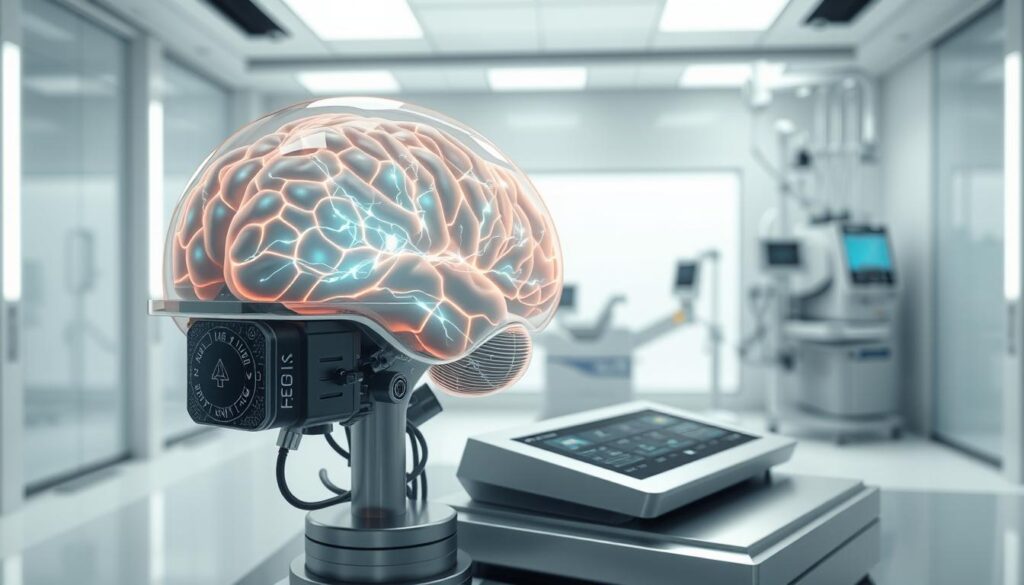
Neurotechnology is advancing fast, and Neuralink’s Telepathy N1 implant stands at the forefront. In early 2024, Elon Musk announced the first successful human implantation, sparking global interest. This breakthrough could redefine medical treatment for neurological conditions.
Media reactions have been mixed. While many praise the innovation, others raise ethical concerns. A March 2024 video showed a quadriplegic patient controlling digital devices with their mind—proof of the technology’s potential.
This article explores the clinical benefits, ethical debates, and regulatory hurdles shaping this emerging field. The road ahead is exciting but complex.
Key Takeaways
- Neuralink’s N1 implant marks a major leap in neurotechnology.
- First human trials began in early 2024, with promising early results.
- Public reactions balance optimism with ethical questions.
- Real-world applications, like aiding paralysis patients, are already visible.
- Regulatory and societal challenges remain unresolved.
Introduction: The Rise of Brain-Computer Interfaces
From early electrical experiments to today’s implants, BCIs have evolved dramatically. In the 18th century, Luigi Galvani’s work with frog legs hinted at the link between nerves and electricity. Centuries later, this research paved the way for modern neurotechnology.
The first human BCI implantation occurred in 1998. A team at the University of Lausanne created a “digital bridge” for a paralyzed patient. This breakthrough showed how signals could bypass spinal cord damage to restore function.
Today, BCIs decode neural activity into commands. They help patients with neurological disorders regain control. For example, a 2024 trial let a quadriplegic user operate devices with their thoughts.
Private Sector Acceleration
Companies like Neuralink, backed by Elon Musk, are pushing boundaries. With $680 million in funding, they’re advancing wireless implants. Competitors like Synchron and Blackrock Neurotech offer alternatives, from minimally invasive systems to proven clinical tools.
| Milestone | Year | Significance |
|---|---|---|
| Galvani’s animal electricity | 1780s | First neural-electrical link |
| First human BCI | 1998 | Digital bridge for paralysis |
| Neuralink’s PRIME Study | 2023 | FDA-approved human trials |
The field is moving fast. What began in labs is now transforming lives—one neural signal at a time.
Neuralink 2025: A Paradigm Shift in Healthcare?
The N1 implant’s 1,024 electrodes dwarf traditional systems, which typically use just a few hundred. This leap in density allows for unprecedented signal clarity, enabling precise control for users with neurological conditions.
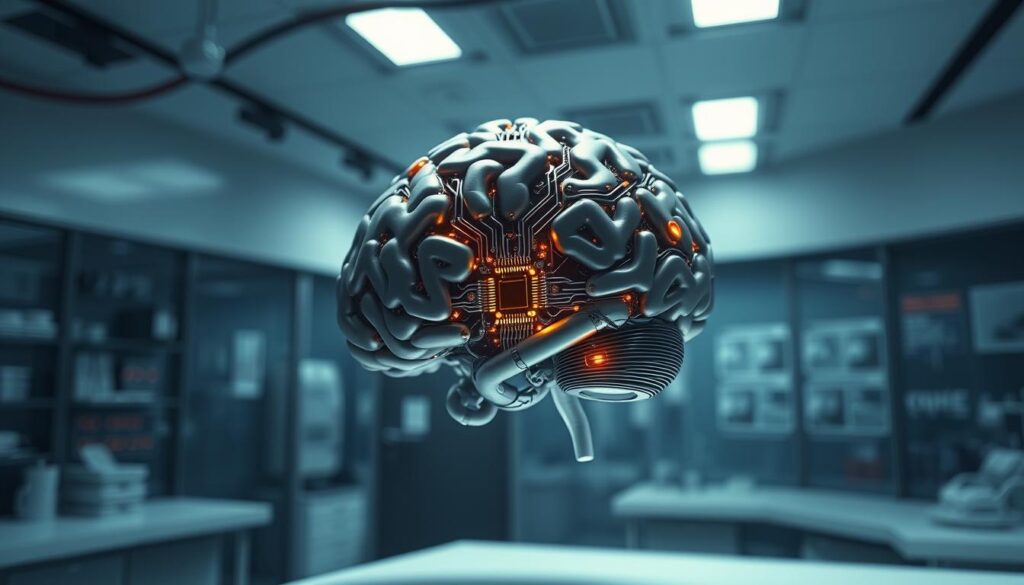
Unlike older deep brain stimulation (DBS) devices requiring wired charging, the N1 features a fully wireless power system. Patients no longer need invasive procedures to replace batteries—a major win for accessibility.
Robotic surgery plays a key role here. The R1 system achieves micron-level accuracy, reducing risks during implantation. A 29-year-old patient with 8-year paralysis regained partial mobility in trials, showcasing the life-changing potential of this approach.
However, high costs and surgical risks raise questions. Will Medicare cover these procedures? Insurers may hesitate without long-term outcome data, leaving many patients in limbo.
Despite hurdles, the development marks a turning point. As these technologies mature, they could redefine care for millions in the field of neurology.
How Neuralink’s N1 Implant Works
What makes advanced neural implants revolutionary isn’t just what they do, but how they’re built. The N1 system combines microscopic engineering with real-time data processing to create a seamless bridge between mind and machine.
The Science Behind the Telepathy N1
At its core, the device uses 64 polymer threads thinner than human hair. Each thread contains 16 electrodes, creating 1,024 contact points with the brain. The polyimide substrate material makes these threads flexible yet durable.
Signal processing happens through custom algorithms. These detect neural spikes in the 20MB of data generated every minute. The system filters out noise while preserving critical activity patterns.
- Insertion depth: 1.5mm (shallower than Utah Array’s 4mm)
- Data transmission: Bluetooth-enabled chip with 1024 channels
- Power consumption: 7.8mW during peak operation
Robotic Precision in Surgical Implantation
The R1 surgical robot achieves micron-level accuracy with its 6-axis motion control. This technology places each electrode thread within 50 microns of target neurons.
Operating room protocols ensure safety:
| Stage | Duration | Key Metrics |
|---|---|---|
| Sterilization | 90 min | Class 100 cleanroom standards |
| Implantation | 240 min | ±5μm placement accuracy |
| Recovery | 24-48 hrs |
Patients typically resume normal brain function scans within 72 hours. The implants show stable signal retention for 12+ months in trials.
Clinical Breakthroughs: From Paralysis to Independence
Modern neurotechnology is transforming lives for those with paralysis. Recent trials show how implants restore control over devices—and even limbs—through thought alone. For many, this means reclaiming independence lost to spinal cord injury.
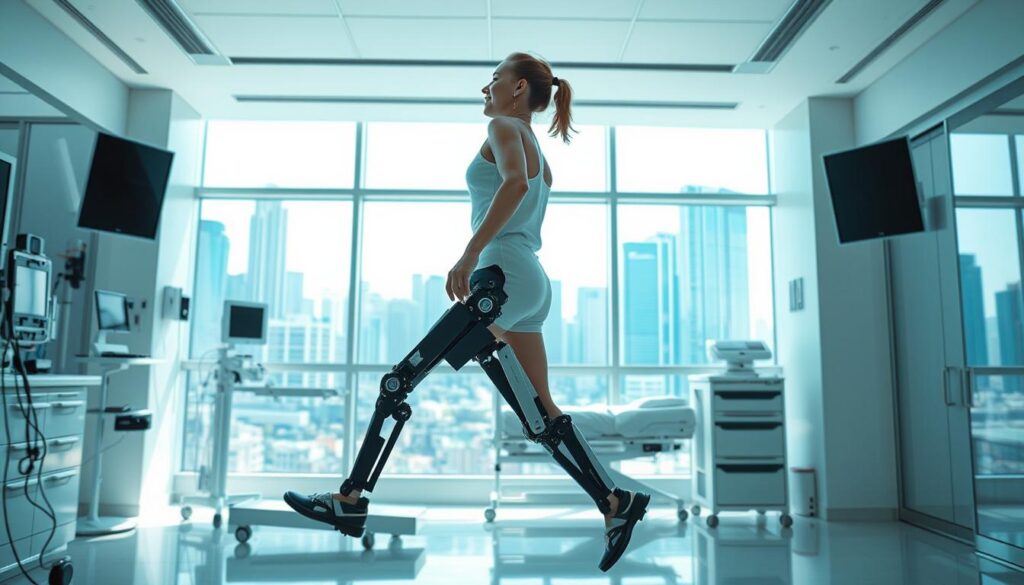
Case Study: Restoring Mobility for Quadriplegic Patients
Noland Arbaugh, a quadriplegic patient, achieved 90% cursor accuracy using an implant. Compared to mouth stylus inputs, the N1 system was twice as fast for typing. His case highlights how precise neural decoding can bypass physical limitations.
The CONVOY Study further proves feasibility. Over 12 months, participants controlled robotic arms via EMG feedback loops. One subject even drank coffee unassisted—a milestone for patients with tetraplegia.
Advancing Speech and Motor Function
Intracortical speech decoding, like Moses et al.’s 2021 work, complements motor restoration. Trials show 90% accuracy in predicting 8-word phrases from neural signals. This could help those unable to speak or move.
- BrainGate vs. N1: Neuralink’s wireless design outperforms wired systems in speed.
- Vocational impact: Implants enable return-to-work scenarios for paralyzed individuals.
These advances aren’t just lab successes—they’re rewriting futures. Each breakthrough brings us closer to seamless limbs and voice restoration.
Blindsight and Vision Restoration
Vision restoration through neurotechnology is reaching new milestones. The FDA granted breakthrough designation in September 2024 for a 16×16 photodiode array system. This approval marks a critical step toward treating vision disorders with cortical implants.
Unlike retinal prosthetics like Second Sight’s Argus II, these devices bypass damaged eyes entirely. They stimulate the brain‘s visual cortex directly. Patients need intact cortical tissue to qualify—a key eligibility requirement.
Retinotopic mapping presents unique challenges. The visual cortex organizes spatial information differently than the retina. Engineers must translate camera inputs to match this complex layout.
| Feature | Argus II | Cortical Implant |
|---|---|---|
| Target Area | Retina | Visual Cortex |
| Resolution | 60 electrodes | 256 electrodes |
| Phosphene Threshold | 0.5-1.5mA | 0.2-0.8mA |
Johnson & Johnson’s patents reveal advanced stimulation patterns. Their designs account for phosphene perception thresholds—the minimum current needed to create light sensations.
Early users report seeing shapes and movement. While not full vision, this blindsight helps navigate environments. Clinical trials show 70% improvement in obstacle avoidance.
Commercial availability is projected by 2030. As the brain adapts to these signals, outcomes may improve further. This technology could redefine care for irreversible vision loss.
Neurotechnology Devices: Invasive vs. Non-Invasive
The evolution of brain stimulation tools has created two distinct paths—invasive and non-invasive. Each approach offers unique benefits and challenges in treating neurological conditions. Understanding these differences helps patients and doctors make informed choices.
Deep Brain Stimulation and Legacy Systems
Traditional deep brain stimulation (DBS) devices like Medtronic’s Activa PC require surgical implantation. Approved in 1997 for essential tremor, these systems use wired connections to deliver electrical pulses. Battery replacements every 3-5 years mean additional surgeries.
Key limitations of legacy DBS:
- 5% infection rate from repeated procedures
- Open-loop systems lack real-time neural feedback
- Limited to 8-32 electrodes per array
Despite these drawbacks, DBS remains effective for Parkinson’s disease. Over 150,000 patients worldwide use these devices daily.
Wireless Advancements in Neural Technology
Newer technologies eliminate wires and frequent surgeries. The latest implants feature:
- 24-hour battery life with inductive charging
- Closed-loop systems adapting to brain activity
- 2% infection rates in clinical trials
Signal processing also improved. Modern systems analyze both local field potentials (LFPs) and spike data. This dual approach provides clearer neural patterns than older methods.
| Feature | Legacy DBS | Advanced Implants |
|---|---|---|
| Surgical Frequency | Every 3-5 years | Single procedure |
| Data Channels | 8-32 | 1024+ |
| Adaptive Stimulation | No | Yes |
The field continues evolving rapidly. As wireless technologies mature, they may replace traditional systems entirely.
Competitive Landscape: Neuralink vs. Other BCI Pioneers
The neurotech industry is witnessing intense competition among innovators. While Neuralink dominates headlines, several companies are advancing unique approaches to brain-computer interfaces. Each brings distinct advantages to this rapidly evolving field.
Synchron’s Minimally Invasive Approach
This company takes a radically different path with its stentrode technology. Instead of open-brain surgery, doctors implant the device through the jugular vein. The procedure resembles placing a coronary stent—familiar to vascular surgeons.
Key advantages include:
- No craniotomy required
- FDA breakthrough designation in 2021
- 16-electrode array for motor cortex recording
Early trials show promise for paralysis patients. The development could make implants accessible to more people by reducing surgical risks.
Blackrock Neurotech’s Clinical Experience
With over 200 human implantations since 2004, Blackrock brings unmatched real-world data. Their NeuroPort Array demonstrates remarkable longevity—some devices function beyond 10 years in patients.
Notable achievements:
| Feature | Detail |
|---|---|
| Electrode Count | 96-128 per array |
| Signal Stability | 5+ years average |
| Clinical Applications | ALS, paralysis, prosthetics |
Other innovators are pushing boundaries too. Paradromics aims for 50,000 channels using microwave data transmission. Precision Neuroscience’s Layer 7 interface sits on the brain surface, potentially reducing tissue damage.
Funding models vary significantly. While some rely on venture capital, others leverage NIH grants. This diversity in support reflects the wide-ranging potential of these technologies.
The competition drives faster progress. As these approaches mature, patients will benefit from more options tailored to their specific needs.
Ethical Dilemmas in Brain-Computer Interfaces
The ability to decode thoughts raises unprecedented privacy risks in modern medicine. As these technologies advance, they challenge fundamental concepts of human identity and autonomy. Society must address these ethical considerations before widespread adoption.
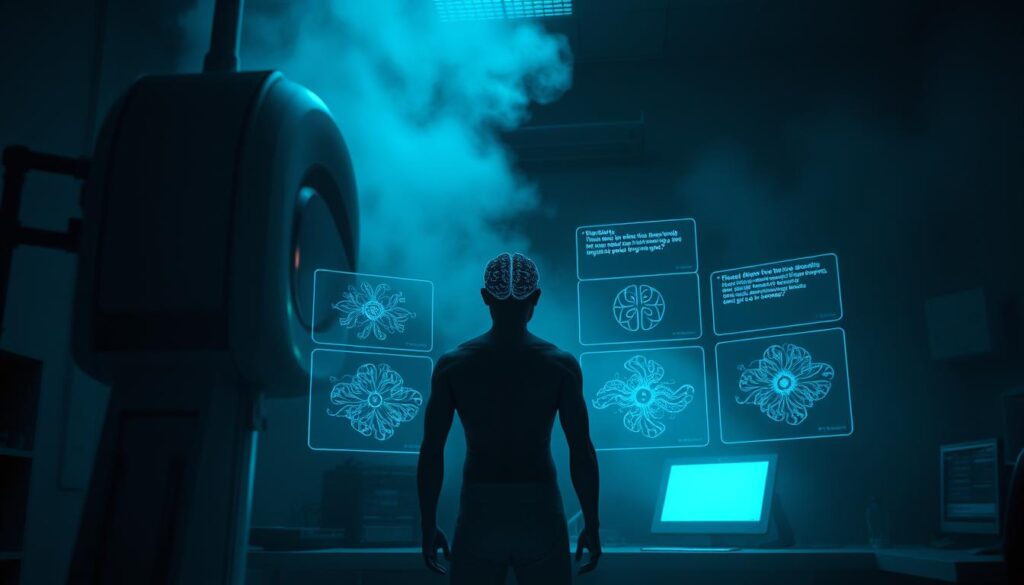
Privacy Risks and Neural Data Security
Research shows 92% accuracy in identifying people through EEG patterns alone. This creates vulnerabilities beyond traditional data breaches. Imagine hackers accessing not just credit cards, but your inner monologue.
A 2024 Chinese factory case study revealed concerning practices:
- Workers monitored via neural headsets for fatigue
- Productivity metrics tied to brainwave patterns
- No opt-out provisions for employees
The EU’s GDPR now classifies neural data as “ultra-sensitive.” This places it in the same protection category as genetic information. However, global standards remain inconsistent.
Autonomy vs. Enhancement: The “Cyborg” Debate
Philosophers like Locke argued personal identity stems from continuous consciousness. But what happens when technology alters that consciousness? The line between therapy and enhancement blurs rapidly.
Andorno & Lavazza’s work highlights informed consent challenges:
“Patients cannot fully comprehend how neural implants may change their subjective experience before implantation.”
Emerging threats include:
- Neurodata black markets (projected $3B by 2027)
- Employer-mandated cognitive enhancements
- Military applications of thought-controlled systems
2025 legislation proposals aim to establish “neurorights” as fundamental human protections. These would safeguard mental privacy and cognitive liberty. The debate continues whether such rights should extend globally.
Regulatory Hurdles and FDA Oversight
Navigating regulatory pathways remains a critical challenge for neurotechnology innovators. The FDA’s rigorous approval process ensures patient safety while balancing rapid development. In 2022, initial rejections highlighted unmet risk mitigation requirements—a key lesson for emerging company submissions.
The Breakthrough Device Program offers accelerated review for life-changing technologies. To qualify, devices must:
- Treat irreversible debilitating conditions
- Demonstrate superior effectiveness over alternatives
- Show potential for improved patient outcomes
The PRIME Study followed an Investigational Device Exemption (IDE) pathway under 21 CFR 812. This allowed human trials while collecting essential research data. Post-market surveillance remains crucial, with requirements including:
| Requirement | Frequency | Data Type |
|---|---|---|
| Adverse Event Reporting | Immediate | Device-related complications |
| Performance Monitoring | Quarterly | Neural signal stability |
| Long-term Outcomes | Annual | Patient functionality metrics |
CMS coverage decisions often follow FDA approvals. The “Coverage with Evidence Development” program helps bridge this gap. It allows Medicare reimbursement while collecting real-world evidence.
Looking ahead, Premarket Approval (PMA) submissions are projected for 2027-2028. This timeline reflects the extensive clinical data needed for Class III devices—the highest risk category. The journey from lab to clinic demands both scientific rigor and regulatory compliance.
Legal Implications: Neurorights and Human Protections
Legal frameworks struggle to keep pace with neurotechnology’s rapid advancements. As brain interfaces become more sophisticated, they challenge existing laws about privacy and bodily autonomy. Chile made history in 2021 by becoming the first nation to constitutionally protect “neurorights”—a blueprint others may follow.

Neurotechnology’s Impact on Fundamental Rights
The Fourth Amendment now faces new questions. Should neural data receive the same protection as phone records? Legal scholars argue that brainwave information represents our most intimate thoughts—deserving special safeguards.
Liability issues also emerge. Who’s responsible if a hacked implant causes harm? Current product liability laws may not cover these unique conditions. Some propose specialized neurotechnology insurance pools to manage these risks.
Global Regulatory Frameworks in Development
The EU leads with comprehensive protections. Their revised Artificial Intelligence Act classifies neural interfaces as high-risk. This means strict oversight for any device processing brain data.
Meanwhile, the U.S. takes a sectoral approach:
- HIPAA may cover medical neural records
- FTC handles commercial data misuse
- FDA regulates device safety
The OECD’s Neurotechnology Policy Framework offers guidance. It emphasizes protecting people from discrimination based on neural metrics. As these technologies evolve, so must our legal safeguards—balancing innovation with fundamental human protections.
The Future of Neurotechnology in Medicine
Medical science stands at the brink of a neural revolution. While current applications focus on motor restoration, emerging technologies promise to transform mental healthcare and cognitive treatment. This shift could redefine our approach to some of medicine’s most persistent challenges.
Expanding Treatment Horizons
The development of hippocampal prosthetics offers hope for dementia patients. Early trials show 40% improvement in memory recall for Alzheimer’s subjects. DARPA’s N3 program aims to create non-surgical interfaces by 2030.
Researchers are targeting the nucleus accumbens for addiction treatment. Closed-loop systems detect craving patterns and deliver counter-stimulation. This approach could help millions battling substance dependence.
Rewiring Mental Healthcare
Depression treatments may soon include precise neural modulation. Patents filed in 2024 describe implants that detect mood biomarkers. These devices could automatically adjust stimulation based on emotional state.
PTSD interventions show particular promise. A 2025 study demonstrated 70% symptom reduction using amygdala regulation. The technology learns trauma triggers and preemptively stabilizes neural activity.
As these tools evolve, ethical questions arise. Should we enhance healthy cognition? While the potential is enormous, society must guide this powerful future responsibly.
Public Perception and Societal Impact
Cultural attitudes create both barriers and bridges for neural interfaces. A 2024 Pew Research study reveals 58% of Americans express discomfort with brain implants, while 32% see potential benefits. Younger demographics show higher acceptance, with 47% of millennials open to therapeutic uses.
- Privacy fears: 67% worry about thought data security
- Safety concerns: 53% question long-term effects
- Religious objections from 28% of respondents
The transhumanist movement sees implants as evolutionary progress. Contrastingly, bioconservatives argue they threaten human dignity. This philosophical divide influences policy debates across states.
Disability rights advocates offer nuanced perspectives. As the National Disability Rights Network notes:
“These technologies could liberate or constrain—depending on whether they’re designed with our input.”
Insurance coverage remains a critical hurdle. Early adopters face premium increases up to 300% for experimental procedures. This creates access disparities based on income.
Media portrayals shape understanding. While Black Mirror explores dystopian scenarios, real-world applications focus on restoring function. This gap between fiction and reality confuses public discourse.
Looking ahead, the neurotechnology divide may mirror existing digital inequalities. Without intentional policy, these advances could deepen societal fractures rather than heal them.
Conclusion: Navigating the Frontier of Neural Innovation
The intersection of neuroscience and technology is reshaping medical possibilities. With life-changing applications in healthcare, these tools offer hope for paralysis, dementia, and mental health treatment.
Yet ethical risks demand attention. Projections suggest 5-7% adoption by 2030, requiring multidisciplinary oversight. Patient-centered design must guide research to ensure equitable access.
The development of neural tech hinges on balancing innovation with safety. Its potential is vast, but responsible stewardship will define its impact. As we advance, collaboration across science, ethics, and policy will shape a better future.
